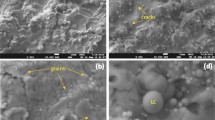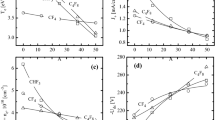Abstract
Two reactive ion etchants, CF4 and SF6, have been compared in terms of plasma characteristics, silicon oxide etch characteristics, extent of RIE damage, and formation of barrier layers on a GaAs surface after oxide etch. It was found that higher etch rates with lower plasma-induced dc bias can be achieved with SF6 plasma relative to CF4 plasma and that this correlates with higher atomic fluorine concentration in SF6 plasma. RIE damage, measured by loss of sheet conductance in a thin highly-doped GaAs layer, could be modelled as a region of deep acceptors at a high concentration in the conductive layer. By relating the sheet conductance change to the modelled damaged layer thickness, it was found that the RIE-damaged thickness from both CF4 and SF6 plasmas had the same linear relation to plasma dc bias. Barriers to subsequent GaAs RIE were created during oxide overetch at the GaAs surface. The barriers were identified by XPS as ∼20 A of GaF3 for CF4 plasma and ∼30 A of GaF3 on top of AsxSy for SF6 plasma. Ellipsometry was used to routinely determine the presence or absence of the barriers which could be removed in dilute ammonia.
Similar content being viewed by others
References
Sang-Mo Shin, Ho-Kyoon Chung, Chung-Hsu Chen and Kin Tan, J. Appl. Phys. 62, 1729 (1987).
Tohru Hara, Hidenori Suzuki and Akio Suga, J. Appl. Phys.62, 4109 (1987).
K. L. Seaward, N. J. Moll, D. J. Coulman and W. F. Stickle,J. Appl. Phys. 61, 2358 (1987).
J. W. Coburn and M. Chen, J. Appl. Phys. 51, 3134 (1980).
Ch. Steinbrüche, H. W. Lehmann and K. Frick, J. Electrochem. Soc. 132, 180 (1985).
S. M. Sze,Physics of Semiconductor Devices, (Wiley, New York, 1981) page 77.
S. W. Pang, G. A. Lincoln, R. W. McClelland, P. D. DeGraff,M. W. Geis and W. J. Piacentini, J. Vac. Sci. Technol. B 1,1334 (1983).
James Comas and C. Burleigh Cooper, J. Appl. Phys. 37, 2820(1966).
Note that GaF3 was not observed by XPS after CCl2F2:He reactive ion etch of GaAs, as described in Ref. 3.
K. L. Seaward, N. J. Moll and W. F. Stickle, J. Vac. Sci. Technol. B 6, 1645 (1988).
CRC Handbook of Chemistry and Physics, ed Robert C. Weast(CRC Press, Boca Raton, 1985), p. B-74 and B-97.
S. J. Fonash, Solid State Technol., April 1985, p. 201.
Author information
Authors and Affiliations
Rights and permissions
About this article
Cite this article
Seaward, K.L., Moll, N.J. & Stickle, W.F. Surface contamination and damage from CF4 and SF6 reactive ion etching of silicon oxide on gallium arsenide. J. Electron. Mater. 19, 385–391 (1990). https://doi.org/10.1007/BF02651301
Received:
Revised:
Issue Date:
DOI: https://doi.org/10.1007/BF02651301




